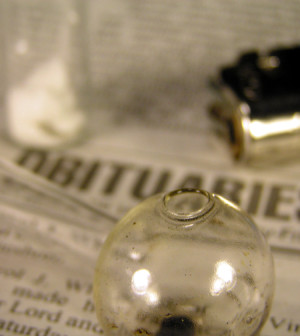- Skip Storing This Everyday Product in the Fridge Door
- Green Tea + B3 Pairing May Boost Brain Health
- Navigating Your Midlife Crisis: Embracing New Possibilities
- City Raccoons Showing Signs of Domestication
- Mapping the Exposome: Science Broadens Focus to Environmental Disease Triggers
- One Week Less on Social Media Linked to Better Mental Health
- Your Brain Changes in Stages as You Age, Study Finds
- Some Suicide Victims Show No Typical Warning Signs, Study Finds
- ByHeart Formula Faces Lawsuits After Babies Sickened With Botulism
- Switch to Vegan Diet Could Cut Your Greenhouse Gas Emissions in Half
Ecstasy Use on Rise Again Among U.S. Teens: Report


The number of U.S. teens who wind up in the emergency room after taking the club drug Ecstasy has more than doubled in recent years, raising concerns that the hallucinogen is back in vogue, federal officials report.
Emergency room visits related to MDMA — known as Ecstasy in pill form and Molly in the newer powder form — increased 128 percent between 2005 and 2011 among people younger than 21. Visits rose from about roughly 4,500 to more than 10,000 during that time, according to a report released Tuesday by the U.S. Substance Abuse and Mental Health Services Administration.
“This should be a wake-up call to everyone, but the problem is much bigger than what the data show,” said Steve Pasierb, president and CEO of The Partnership at Drugfree.org. “These are only the cases that roll into the emergency rooms. It’s just the tip of the iceberg.”
The SAMHSA study comes on the heels of a string of Ecstasy-related deaths. Organizers closed the Electric Zoo music festival in New York City one day early in August following two deaths and four hospitalizations caused by Ecstasy overdoses. The deaths came a week after another young man died from Ecstasy overdose at a rock show in Boston.
Ecstasy produces feelings of increased energy and euphoria, and can distort a person’s senses and perception of time. It works by altering the brain’s chemistry, but research has been inconclusive regarding the effects of long-term abuse on the brain, Pasierb said.
However, ecstasy abuse can cause potentially harmful physical reactions, Pasierb said. Users can become dangerously overheated and experience rapid heartbeat, increased blood pressure and dehydration, all of which can lead to kidney or heart failure.
Alcohol also appears to be a factor. One-third of the emergency room visits involving Ecstasy also involved alcohol, a combination that can cause a longer-lasting euphoria, according to SAMHSA. Teens can become less aware of how much alcohol they’ve consumed, and also can be more likely to make poor decisions that lead to bodily harm.
The newest form of MDMA, the powder Molly, appears to be driving the latest surge in Ecstasy use.
The study relied on data produced by the Drug Abuse Warning Network, a public health surveillance system that monitors drug-related hospital emergency department visits and drug-related deaths.
MDMA affects a person’s level of serotonin, a hormone that helps regulate sleep cycles and is responsible for feelings of happiness and well-being, said Peter Delany, director of SAMHSA’s Center for Behavioral Health Statistics and Quality. Overuse can cause depression, confusion, paranoia, anxiety and sleep disorders.
The Molly that currently is on the streets is usually a very pure crystalline form of MDMA, Delany said. Users can snort it, mix it in alcohol or some other liquid, or take it in a gel cap.
Delany noted that the number of emergency room visits caused by MDMA pales in comparison to the 1.5 million ER visits linked to drug use every year, but said both the rapid increase and the age of the victims are causes for concern.
The use of alcohol with MDMA can create a person who is drunk but hyper-aware, said Delany, comparing it to giving coffee to a drunk person. “You don’t want that, because then you have a wide-awake drunk,” he said.
For his part, Pasierb noted how Ecstasy’s popularity has fluctuated.
Ecstasy underwent a huge rise in use between 1999 and 2001, where it jumped from the club scene and into the mainstream, Pasierb said. Then news of deaths related to Ecstasy began to circulate, and use plummeted.
“We’ve had this six-year quiet lull, and now we’ve got a whole new generation of young people who are being marketed a new product under the name ‘Molly,'” he said.
Molly presents additional problems because it is a powder, and often contains a cocktail of chemicals in addition to MDMA, Pasierb said.
“When it was in a finished pill, it was difficult to tamper with,” he said. “But now that it comes in a powder form, you might have an unscrupulous dealer who cuts it with speed or some other substance.”
More information
For more about Ecstasy, visit the U.S. National Institute on Drug Abuse.
Source: HealthDay
Copyright © 2025 HealthDay. All rights reserved.










